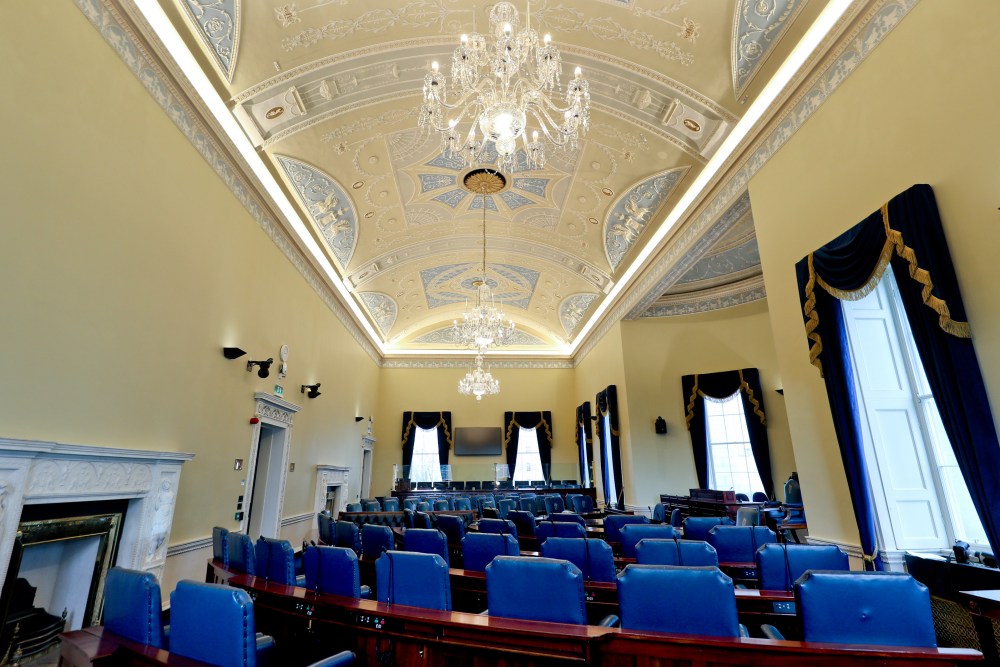Locally, three prominent political figures are contesting the Seanad Elections, including outgoing senators Aisling Dolan and Eugene Murphy, who were both unsuccessful in November’s General Election in Roscommon-Galway constituency.
Senator Eugene Murphy (formerly FF and presently non-party, Scramogue), Senator Aisling Dolan (FG, Ballinasloe), and Senator Joe Flaherty (FF, Lanesborough) are competing for seats on three separate vocational panels.
Murphy is contesting the Agricultural Panel, as is Fine Gael’s Aisling Dolan. Both are fighting for an outside seat on their respective panels.
Joe Flaherty, a native of Lanesborough and a former Roscommon Champion reporter, lost his Dáil seat in Longford/Westmeath, but was appointed to the Seanad subsequently by Taoiseach Simon Harris. He is contesting the Cultural and Educational panel with an inside nomination.
The Seanad: All you need to know…
The Seanad: A guide to Ireland’s mysterious Upper House
A touch mysterious, a tad elitist, but undeniably fascinating… EMMETT CORCORAN’S guide to the Seanad

So, what exactly is the Seanad? Why does it even exist?
Ah, Seanad Éireann – the Upper House of the Irish parliament, Oireachtas. Think of it as the more refined, intellectual sibling to Dáil Éireann, the lower house where all the shouting and high-stakes politics happens. The Seanad, by contrast, was designed to be… calmer, let’s say. Almost aristocratic in tone, though not by title.
Its roots go back to the 1937 Constitution, drafted under Éamon de Valera. Dev had this idea: democracy was all well and good, but could you trust it to deliver thoughtful, educated decision-making? Especially in a country still emerging from revolution and grappling with widespread poverty and illiteracy. The Seanad was meant to counterbalance the Dáil’s rowdy, populist tendencies with something a little more… sophisticated.
Sophisticated? That’s a polite way of saying elitist, isn’t it?
Bingo. De Valera envisioned the Seanad as an intellectual haven. Not a body elected by the masses – heavens no! Instead, it would be a home for experts, academics, and vocational representatives. Think of it as a safeguard, a kind of intellectual quality control for Irish law-making.
In fairness to Dev, literacy rates in 1930s and 1940s Ireland weren’t what they are today. The popular vote didn’t guarantee that the people’s representatives could even read the legislation they were debating. The Seanad was his attempt to inject some expertise into politics, albeit in a way that kept the hoi polloi at arm’s length.
Right, but how does it actually work? Who gets to sit in the Seanad?
Now you’re asking the big questions. Seanad seats are divided into a complex system of panels and nominations.
Let’s break it down:
- Taoiseach’s nominees: Eleven members are directly appointed by the Taoiseach. This gives the government of the day a significant foothold in the Seanad and ensures it’s not completely out of step with the Dáil.
- University seats: Six members are elected by graduates – three from the National University of Ireland (NUI) and three from Trinity College Dublin (TCD). These reflect the elitist origins of the Seanad – voting rights are based on education. Historically, these two institutions were chosen because they represented distinct strands of Irish identity: TCD for the Anglo-Irish Protestant tradition and NUI for the Catholic nationalist majority.
- Vocational panels: The real Gordian knot of the Seanad. These panels, introduced under the Seanad Electoral (Panel Members) Act 1947, were intended to represent specific sectors of society. There are five panels – Cultural and Educational, Agricultural, Labour, Industrial and Commercial, and Administrative – each supposedly linked to areas vital to the nation’s wellbeing.
That all sounds very noble. Is it?
In theory, yes. In practice, well, not so much. The vocational panels were supposed to elevate representatives of industry, agriculture, labour, and culture – experts in their fields, contributing to national discourse. What they often end up being is a convenient safety net for political parties.
A safety net?
Picture this: you’re a TD (a member of the Dáil) who’s just lost their seat in a General Election. Ouch. But don’t worry – your party can try to get you onto one of the vocational panels in the Seanad. Think of it as a crèche for young politicians or a nursing home for the politically elderly. Cynical? Maybe. But it’s hard to ignore how often the panels are used this way.
And how does voting for these panels work? Surely the public gets a say?
Not exactly. The electorate for the vocational panels is made up of existing TDs, senators, and members of county and city councils. It’s a closed shop, really – ordinary citizens don’t get a look in. This system has led to criticism that the Seanad is unaccountable and overly political, despite its high-minded origins.
So how does the Seanad differ from the Dáil in terms of power?
Ah, now we’re getting to it. The Seanad can’t veto legislation outright – it can only delay it. It acts as a reviewing body, providing a second opinion on bills passed by the Dáil. While this sounds like a weak role, it’s not without influence. The Seanad has occasionally been a thorn in the side of governments, forcing amendments or slowing down contentious legislation.
If it’s so limited in power terms, why keep it around?
Good question. There’s been plenty of debate about abolishing the Seanad altogether. In fact, there was a referendum on the issue in 2013. The people narrowly voted to keep it, perhaps because they weren’t convinced the Dáil could manage without some sort of oversight.
And the university seats – do they still make sense?
That’s another bone of contention. Many argue the university seats are outdated and elitist, excluding graduates from institutions outside NUI and TCD. There’s been talk of reforming this, but progress has been slow. Some see these seats as an anachronism in a modern, democratic State, while others argue they bring a unique perspective to the Seanad.
So, what’s the verdict – does the Seanad still matter?
It depends on who you ask. Critics see it as an irrelevant relic, ripe for reform or abolition. Supporters argue it’s a necessary counterbalance to the Dáil, even if its structure could use a serious overhaul. What’s clear is that the Seanad is a peculiar institution – part high-minded ideal, part political pragmatism. Love it or loathe it, it remains a cornerstone of Irish politics, even if few truly understand how it works.
Well, now I do. Sort of. I think.
I am certain that there is a Seanad scholar (or two) who will correct me if I’ve inadvertently misrepresented the history, function or practice of the Seanad; but there you have it – a deepish dive into the arcane world of the Seanad. A touch mysterious, a tad elitist, but undeniably fascinating.
Qualifications? Nominations? Inside or outside?
Okay, so, if the explanation above so far is clear to you, this is where the waters get, let us say, murky, to say the least. And if you have already given up, I don’t blame you; if I wasn’t as stubborn as a mule, I’d have given up on trying to make sense of this Seanad-y yoke weeks ago…
So, I genuinely am trying to make this seemingly nonsensical electoral system make sense – but better men and women than I have tried and failed – but let’s give it a shot:
Each of the five vocational panels outlined above is divided into two sub-panels, an inner sub-panel and an outer sub-panel. But before we go there, there is the qualification – one must be suitably qualified for the vocational panel they are contesting. For example, a lifelong trade unionist would qualify for the Labour Panel, and few others would. Whereas qualifying for the Agricultural Panel could be demonstrated by one being a farmer or having attained a related qualification such as a Degree in Horticulture or even having been an active member of a farmer representative body such as the Irish Farmers Association (IFA).
The nominations for the inner sub-panels are controlled by incoming TDs and outgoing senators, collectively. Any four of these current Oireachtas members can collaborate in order to nominate candidates for the inside sub-panels of each of the vocational panels but each member can only join in one nomination in total.
In contrast to the explicitly politically-elitist process of the inner sub-panels, the outer sub-panel nominations emit a whiff of democracy, insofar as there are over 100 possible nominating bodies such as the Irish Thoroughbred Breeders’ Association which can nominate a vocational expert to contest the Agricultural Panel or the Irish Congress of Trade Unions (ICTU) which can nominate a vocational expert to contest the Labour Panel. These organisations glean their nominating powers from the 1947 Act, and suffice to say, the qualifying and nominating processes are as antiquated as the year the Act was passed into law.
Having exhibited one’s qualifications to stand for a particular vocational panel one must then get a nomination. As outlined above, these are either inside (Oireachtas members) or outside (nominating bodies). But, when all is said and done the inner and outer panels come into effect when the votes are counted. Each panel must fulfill its own complement of inner and outer seats. For example, the Agricultural Panel is constituted of five inner-seats and five outer-seats, with one floater. There are eleven seats in total on the Agriculture Panel, but given its format the panel must elect five candidates put forward by the outside nominating bodies and five candidates put forward by the inside Oireachtas nominators.
So, regardless of how many votes a candidate receives, they may well be scuppered by which sub-panel they have been nominated to, in that, a candidate contesting the outside sub-panel might well be defeated by a candidate with less votes contesting the inside sub-panel because there are still inside seats to fill on the panel and the full complement of outside seats has already been realised. And if that makes sense to you, congratulations – you’re a verifiable mathematical genius. Because while it legitimately does make perfect sense in my head, I’m sure it makes less than no sense on paper and I have failed miserably to articulate the complex nuances of the inner and outer Seanad sub-panels.






